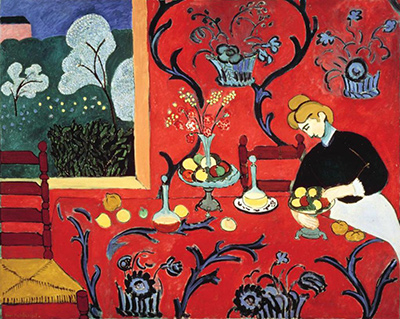In 1908 Henri Matisse created one of his most important works of the period. The artist himself called this oil on canvas a “decorative panel” and it was intended for the dining room in the Moscow mansion of the famous Russian collector Sergey Shchukin.
The Dessert: Harmony in Red was originally commissioned as ‘Harmony in Blue’, but Matisse was disappointed with the result so painted over it with his preferred red.
The colour selection generates a feeling of warmth and comfort, whilst contrasting richly and intensely with other elements within the composition. Matisse used a common theme for the painting – a room decorated with vases, fruits and flowers –yet took the painting beyond the normal parameters of his work.
As he wrote in 1908, "the basis of my thinking has not changed, but the very thinking has evolved and my means of expression have followed on."
The luxuriant raspberry red fabric with its energetic twists of blue seems to hang from the wall, engulfing the surface of the table and swallowing up the three-dimensional space of the room.
Despite the flatness of the red colour, the artist managed to create within it the impression of space; an area within which the maid leaning over the vase could move and within which the harsh view of the chair seemed oddly natural. The window, through which a green garden with flowering plants is visible, allows the eye to move into the depths of the canvas.
The rhythms of the foliage pattern on the tablecloth and wallpaper are repeated in the window in the background, uniting the warm interior with the cool exterior. The Dessert: Harmony in Red is a celebrated triumph of pattern and decoration and is considered by critics to be one of the most powerful examples of fauvist art.




